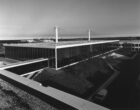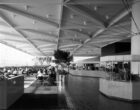In a new column in MAS Context, architectural historian Elizabeth Blasius laments the pandemic-accelerated loss of architecturally significant modernist suburban campuses as digital logistics takes command of real estate. Once coveted as a bucolic backdrop for aspirational architecture to house a post-war workforce, these sites are now being assessed only in terms of their size and location without regard for the existing buildings in order to redevelop them as last-mile distribution centers for e-commerce tenants or other resource-intensive infrastructure.
Surveying the greater Chicago region, Blasius identifies two SOM projects at risk. One project, United Airlines’ Executive Office Building and Education and Training Center in Elk Grove Village, is currently being demolished to make room for a $2.5-billion data center. The other remains intact, but perhaps not for long: After nearly 50 years, the original owner-occupier Baxter International (formerly known as Baxter Travenol) is selling its 1975 headquarters campus to an industrial developer that has proposed to raze the structures in order to build a warehouse hub.


Like the John Hancock Center and the Sears Tower (both designed at the same time as Baxter), the one-million-square-foot campus exemplifies the close collaboration between renowned SOM engineer Fazlur Khan and architect Bruce Graham. Whereas the projects in downtown Chicago achieved new heights, Baxter’s signature campus center was an exercise in creating horizontal space: The suspension-bridge-like cable-stayed structure provides column-free interiors for a cafeteria, auditorium, and training center—spaces that are still in use today—anchored by twin masts that are visible from a nearby expressway as a regional landmark. As SOM Consulting Partner Bill Baker explains, “There were only two columns holding up the whole building.”

Read on for more insight into the design and engineering innovations behind this award-winning project—designed as a series of “flexible, modular spaces to allow the company to expand as it grew”—and possible alternative futures for this unsung typology.
